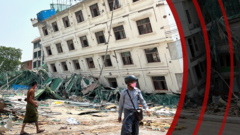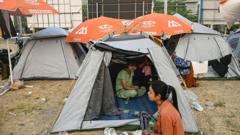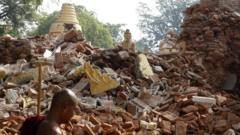The quake, which struck near San Diego, raised concerns but resulted in no injuries or structural damage according to officials.
**5.2-Magnitude Earthquake Shakes San Diego Area, No Major Damage Reported**

**5.2-Magnitude Earthquake Shakes San Diego Area, No Major Damage Reported**
A 5.2 quake centered in Julian jolted Southern California, triggering emergency alerts and minor aftershocks.
In a startling turn of events, a 5.2-magnitude earthquake rocked San Diego and its neighboring communities on Monday afternoon, the United States Geological Survey (USGS) confirmed. The quake hit at 10:08 AM local time, with its epicenter located in the picturesque resort town of Julian, nestled in the Cuyamaca Mountains, approximately an hour northeast of the bustling city.
In the hours following the quake, City of San Diego spokeswoman Perette Godwin informed BBC that there were no reports of significant structural damage or injuries, a sentiment echoed by the San Diego sheriff’s office, which described the scenario as a "developing situation."
California Governor Gavin Newsom's office quickly took to social media platform X to confirm he was briefed on the trembling situation. In the immediate aftermath, the USGS documented a series of smaller aftershocks in the vicinity, reassuring residents while the National Weather Service confirmed that no tsunami would follow.
Emergency alerts from the USGS prompted residents to seek shelter, extending precautions as far north as Los Angeles. "Drop, cover, hold on. Protect yourself," read the safety message. Kevin Manaugh, a San Diego resident, shared his experience, noting he was eating breakfast when he received the alert and sought safety under a door frame.
"It was a bit shocking," he stated, recalling the intense shaking that lasted around three seconds. Having lived in San Diego all his life, he described this quake as likely the worst he had ever experienced. Thankfully, his home emerged unscathed, prompting him to consider better preparedness for future seismic events. "It made me think that it's probably a good idea to have an evacuation bag," he added.
Earthquakes, by their nature, are notoriously unpredictable, but the 15-second lead time from alerts allowed for critical safety measures for residents like Mr. Manaugh. As the region assesses the impact of the quake, the emphasis remains on preparedness and safety in this earthquake-prone landscape.
In the hours following the quake, City of San Diego spokeswoman Perette Godwin informed BBC that there were no reports of significant structural damage or injuries, a sentiment echoed by the San Diego sheriff’s office, which described the scenario as a "developing situation."
California Governor Gavin Newsom's office quickly took to social media platform X to confirm he was briefed on the trembling situation. In the immediate aftermath, the USGS documented a series of smaller aftershocks in the vicinity, reassuring residents while the National Weather Service confirmed that no tsunami would follow.
Emergency alerts from the USGS prompted residents to seek shelter, extending precautions as far north as Los Angeles. "Drop, cover, hold on. Protect yourself," read the safety message. Kevin Manaugh, a San Diego resident, shared his experience, noting he was eating breakfast when he received the alert and sought safety under a door frame.
"It was a bit shocking," he stated, recalling the intense shaking that lasted around three seconds. Having lived in San Diego all his life, he described this quake as likely the worst he had ever experienced. Thankfully, his home emerged unscathed, prompting him to consider better preparedness for future seismic events. "It made me think that it's probably a good idea to have an evacuation bag," he added.
Earthquakes, by their nature, are notoriously unpredictable, but the 15-second lead time from alerts allowed for critical safety measures for residents like Mr. Manaugh. As the region assesses the impact of the quake, the emphasis remains on preparedness and safety in this earthquake-prone landscape.

















